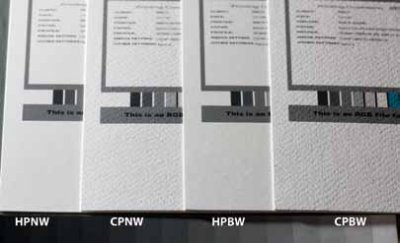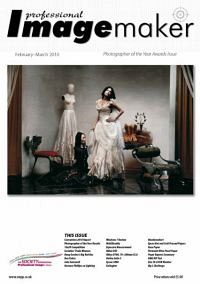articles/Paper/epsonhotcold-page2
Great Paper Chase Epson Hot ande Cold Pressed Paper - part 2 of 1 2 3
by Mike McNamee Published 01/02/2010

Hot Pressed Natural White
As expected this paper has a really fine finish, almost polished. The statistics did not reach the dizzy heights of the cold-pressed version but remained remarkably good. Visually the Hot Press and Cold Press versions of the papers were very close. The Hot Press had about two more RGB points of highlight detail, which was also shown in a slightly higher overall print density (only by 0.3% though). For all practical purposes the test prints were identical, useful if the same print has to be compared on a smooth and textured finish - you can be assured that there will be a visual colour match between the two.
Monochrome
This paper is ideal for the purist monochrome worker. With its museum-grade properties and lack of OBAs it pushes all the right buttons. We tested it using the Epson ABW driver set to 'light' and 'neutral', our usual settings. This created a good-looking print with just a hint of warmth in the highlights. It was very slightly biased towards cyan (see graph) and a slight tweak in the ABW driver would eliminate the effect for the ultra-critical. The graph shows a drift of between a half and one point towards cyan from the base paper neutral shown as the solid black diamond.
Cold Pressed Bright White
This is an optically brightened paper which stands out when placed alongside its 'natural' cousins. In the UV booth it did not really leap out (thankfully) and so the OBA lift is relatively restrained, it only gets up to 101%.
Colour Audit
Despite the OBAs, the audit data was gratifyingly good, especially the skin tones which normally suffer as the coolness of OBA-laden papers drags them cooler and less saturated. We thus ended up with rich flesh tones in which the saturation error was a minuscule 0.6ΔE₀₀. It seems that here we have the best of both worlds as the bright paper has also held the 'landscape ' tones very well also. Once again the high error was the deep blue which was a full 10 points out, remember though that colours in this part of the spectrum are relatively masked from human detection. The Dmax was a high 1.63.
Monochrome
Using the ABW driver created a clean print of great depth and fine detail retention. The spectro measurements on the print were rather scattered but this was not detected in the print itself. Our judgement was that no adjustments would be needed to the default settings. The use of the cool settings in the ABW driver in conjunction with the matching coolness of the paper offers some interesting artistic alternatives for the mono specialist.
Please Note:
There is more than one page for this Article.
You are currently on page 2
- Great Paper Chase Epson Hot ande Cold Pressed Paper page 1
- Great Paper Chase Epson Hot ande Cold Pressed Paper page 2
- Great Paper Chase Epson Hot ande Cold Pressed Paper page 3
1st Published 01/02/2010
last update 09/12/2022 14:53:56
More Paper Articles
There are 28 days to get ready for The Society of Photographers Convention and Trade Show at The Novotel London West, Hammersmith ...
which starts on Wednesday 14th January 2026





